
A solo classical Indian dance form of religious origin performed traditionally
by women. It is believed by some scholars to be more than 3, 000 years old and
was once performed by Hindu temple dancers, or devadasis. Today it is to be
found mostly in southern India, in the Madras region, although exponents have
exported the artform to the West, particularly Britain, where it is popular with
non-Asian audiences. Much of its traditional repertoire derives from the early
part of the 19th century when four brothers, known as the Tanjore Quartet,
codified it.
Traditional performances can last up to three hours. The emphasis
in the choreography is on the upper body, and the style is distinguished by its
low centre of gravity, its rhythmic footwork, its straight spine, and its
extensive vocabulary of hand gestures which carry dramatic meaning. The face is
also used for expressive purposes, with the eyes, nose, and mouth all possessing
their own specific choreographic language. The dance is in six parts, beginning
with alarippu, which invokes the deity and greets the audience.
The style
incorporates all three aspects of Indian dance: nrtta (abstract, pure, and
rhythmic), nrtya (expressive, rhythmic, and narrative), and natya (pure
storytelling, a combination of song and dance). The performance ends with
tillana, a purely rhythmic coda designed to showcase the dancer's mastery of
complex rhythms. The dancer wears a silk sari, usually decorated with gold, and
her feet are bare, although bells are worn around the ankle. In Britain the
Chennai-born choreographer Shobana Jeyasingh has successfully blended bharata
natyam and Western contemporary dance styles.

Bharatanatyam is an ancient classical dance style, with sculptural evidence
dating back over 2000 years. A highly spiritual and dedicatory dance,
Bharatanatyam is rooted in the Hindu temples of Tamil Nadu, in South India. The
dance moved from temples to theaters over time, but has retained its
characteristic devotional component and expression of human emotions. In its
present form, Bharatanatyam is approximately 200 years old.


Bharatanatyam is comprised of two main aspects - nritta, or pure technical
dance, with a sophisticated base vocabulary used to build intricate combinations
and rhythmic patterns; and nritya (also called abhinaya), or expressional dance,
using highly stylized gestures, postures and body language to express any mood
or story. Traditionally, the storytelling focuses on legends from Hindu
mythology, but the techniques have now been adapted to stories of all kinds.
Bharatanatyam is a classical dance form originating from Tamil Nadu, a state in
Southern India. This popular South Indian dance form called Bharatanatyam is a
20th century reconstruction of Cathir, the art of temple dancers. Cathir in
turn, is derived from ancient dance forms. The word Bharata, some believe,
signifies the author of the famous Sanskrit treatise on stagecraft, called
NatyaShastra, and the word Bharatanatyam is sometimes given a folk etymology as
follows:Bha for Bhava or abhinaya and expression, Ra for raga or melody, and Ta
for tala or rhythm.
Bharatanatyam: Bharata refers to the author of the Natya Shastra, and natya is
Sanskrit for the art of sacred dance-drama brought to the stage at the beginning
of the 20th century.

Traditional roots
Bharatanatyam: Bharatanatyam traces its origins to the Natya Shastra written by
Bharata Muni, a Hindu sage. The Natya Shastra is also called the fifth Veda in
reference to the foundation of Hindu religion and philosophy, from which sprang
the related South Indian musical tradition of Carnatic music.

In ancient times it was performed as dasiattam by mandir (Hindu temple)
Devadasis. Many of the ancient sculptures in Hindu temples are based on Bharata
Natyam dance postures karanas. In fact, it is the celestial dancers, apsaras,
who are depicted in many scriptures dancing the heavenly version of what is
known on earth as Bharatanatyam. In the most essential sense, a Hindu deity is a
revered royal guest in his temple/abode, to be offered a standard set of
religious services called Sodasa Upacharas ("sixteen hospitalities") among which
are music and dance, pleasing to the senses. Thus, many Hindu temples
traditionally maintained complements of trained musicians and dancers, as did
Indian rulers.

Bharata Natyam as a dance form and carnatic music set to it are deeply grounded
in Bhakti. Bharata Natyam, it is said, is the embodiment of music in visual
form, a ceremony, and an act of devotion. Dance and music are inseparable forms;
only with Sangeetam (words or syllables set to raga or melody) can dance be
conceptualized.

Essential ideas
Bharatanatyam is considered to be a fire-dance — the mystic manifestation of the
metaphysical element of fire in the human body. It is one of the five major
styles (one for each element) that include Odissi (element of water), and
Mohiniattam (element of air). The movements of an authentic Bharatanatyam dancer
resemble the movements of a dancing flame.

Contemporary Bharatanatyam is rarely practiced as Natya Yoga, a sacred Hindu
meditational tradition, except by a few orthodox schools.

Nataraja (King of Dance)
Bharatanatyam is the manifestation of the South Indian idea of the celebration
of the eternal universe through the celebration of the beauty of the material
body. In Hindu mythology the whole universe is the dance of the Supreme Dancer,
Nataraja, a name for Lord Shiva, the Hindu ascetic yogi and divine purveyor of
destruction of evil.

Natya Shastra (I.44) reads, "... I have seen the Kaisiki style during the dance
of the blue-throated lord (Shiva). It consists of elaborate gestures (Mridu
Angaharas, movements of limbs), sentiments (Rasas), emotional states (Bhavas).
Actions (Kriyas) are its soul. The costume should be charmingly beautiful and
the erotic sentiment (Sringara) is its foundation. It cannot be adequately
portrayed by men. Except for women, none can practise it properly".

The symbolism of the dance of Shiva (in the form of Nataraja) is represented by
the attitude called "Ananda Tandavam". Also known as the cosmic dancer, he is
here the embodiment and manifestation of the eternal energy in five activities (panca-kriya
??????????): creation, pouring forth, unfolding; maintenance or duration (sthiti
??????); destruction or taking back (smhara ??????); concealing, veiling, hiding
the transcendental essence behind the garb of apparations (tirobhava ??????);
and favoring, bestowing grace through a manifestation that accepts the devotee (anugraha
???????). Shiva is depicted dancing on the dwarfish body of the demon Apasmara
purusa, "forgetfulness, loss of memory" called in Tamil Muyalaka (?????) -- who
represents ignorance, the destruction of which brings enlightenment, true
wisdom, and release from the bondage of existences.

Medieval decline
Local kings often invited temple dancers devadasi (Servants of God) to dance in
their courts, the occurrence of which created a new category of dancers --
rajanarthakis -- and modified the technique and themes of the recitals. A
devadasi had to satisfy her own soul while she danced unwatched and offered
herself (surrendered) to the Lord, but the rajanarthaki's dance was meant to be
an entertainment.

Although most of the contemporary Bharatanatyam ballets are popularly viewed as
a form of entertainment, the Natya Shastra-based dance styles were sacred Hindu
ceremonies originally conceived in order to spiritually elevate the spectators.
Bharatanatyam proper is a solo dance, with two aspects, lasya, the graceful
feminine lines and movements, and tandava (the dance of Shiva), masculine
aspect, which is identical to the Yin and Yang in the Chinese culture.

The famous quartet of Chinnayya, Ponniah, Sivanandam and Vadivelu of the Tanjore
Court, during the rule of Maratha King Saraboji II (1798- 1832), made a rich
contribution to music and Bharatanatyam and also completed the process of
re-editing the Bharathanatyam programme into its present shape with its various
items. The descendants of these four brothers formed the original stock of
Nattuvanars or dance teachers of Bharatanatyam in Tanjore. Originally, they
formed a community by themselves and most of them were Shaivite non-brahmins.

Modern rebirth
Krishna Iyer was one of those who raised the social status of Bharatanatyam and
greatly popularized it. Rukmini Devi Arundale was also instrumental in modifying
mainly the Pandanallur style of Bharatanatyam and bringing it to the attention
of the West. According to Shri Sankara Menon, Rukmini Devi raised Bharatanatyam
to a puritan art form, divorced from its recently controversial past by
"removing objectionable elements" (mostly, the Sringar, certain emotional
elements evocative of the erotic) from the Pandanallur style, which was publicly
criticized by Balasaraswati and other representatives of the traditional
devadasi culture. Not all love was portrayed, at least outside parameters
considered "chaste". Balasaraswati said that "the effort to purify Bharatanatyam
through the introduction of novel ideas is like putting a gloss on burnished
gold or painting the lotus".

While the Pandanallur style, Tanjore or Thanjavur, Vazhuvoor, Mysore,
Kancheepuram were based on the art of rajadasis and are exoteric in nature, some
others, like the Melattur style and Balasaraswati's style grew out of the
devadasis' distinctly different esoteric art.

The development of the Bharatnatyam dance form has therefore been surrounded by
controversy as some including Ashish Khokar the Indian dance historian have seen
it as a means by which many women, often Brahmin women, have appropriated
certain Devadasi traditions while disassociating themselves with other aspects
of the contemporary devadasis' practices.

Having studied Bharatanatyam for three years, in 1936 Rukmini Devi Arundale
founded the school Kalakshetra outside the city of Madras to teach it and to
promote other studies in Indian music and art. She was one of first teachers to
instruct a few men to perform the dance. The dance, at that time, was
exclusively performed by women, while men, called Nattuvanars, had only been
teaching Bharatanatyam without actually performing it. It is worth noticing that
most of the contemporary Bharatanatyam dancers do not satisfy the criteria for a
professional danceuse stated in the scriptures.

At present, Bharatanatyam recitals are usually not performed inside the temple
shrine but outside it, and even outside the temple compounds at various
festivals. Most contemporary performances are given on the stage with a live
ensemble. In popular culture, the adapted, or "semi-classical", Bharatanatyam
has been exposed largely through depiction in popular movies and TV programs.

Learning Bharatanatyam normally takes many years before the arangetram (debut).
There are academic and commercialized dance institutes in many countries. Many
people choose to learn Carnatic music along with Bharatanatyam as they go
together, since both Carnatic music and Bharatanatyam are of purely Indian
origins, while Hindustani music and Kathak are a mix of Persian and Indian art.

At present, not only the Hindus but many Christians and Muslims learn it,
bringing it beyond the rigid forms of religious boundaries.

Technique
Includes
Abhinaya or Natya - dramatic art of story-telling in Bharatanatyam
Nritta - pure dance movements usually performed as an opening item in
Bharatanatyam, reflecting different rhythms of the universe
Nritya combination of abhinaya and nritta

Karanas
Karanas are the 108 key poses and transitions that punctuate Bharatanatyam and
other classical Indian dances. Most of these 108 are not static postures, nor
are they merely transitional, i.e. the dancer is usually supposed to stop and
maintain these for a very brief duration (0.5 sec). Padma Subrahmaniam and some
other researchers have made attempts to reconstruct these since the 1960s, from
108 brief movement phrases describing specific leg, hip, body, and arm movements
accompanied by hasta mudras described in the Natya Shastra, and from depictions
of the movements in sculpture in five South Indian temples.

Hasta Mudras
A distinctive feature of Bharata Natyam Dance is the use of expressive hand
gestures as a way of communication. Hasta Mudras refers to the varieties of hand
symbols that a dancer can use. Many of these hand gestures are well known. For
example, Anjali is often used as a salutation when a person greets another
person.

There are two types of Hasta Mudras: Asamyuta and Samyuta (single and combined,
respectively).

There are 28 Asamyuta Mudras which are: Pataka, Tripataka, Ardhya-pataka,
Kartari-mukha, Mayura, Ardha-chandra, Arala, Shukatundaka, Mushti, Shikhara,
Kapittha, Kataka-mukha, Suchi, Chandra-kala, Padma-kosha, Sarpa-shirsha,
Mriga-shirsha, Simha-mukha, Langula, Sola-padma, Chatura, Bhramara, Hamsaya,
Hamsa-paksha, Samdasma, Mukula, Tamrachuda, and Trishula. Note that hand "mudras"
are usually spoken in sanskrit (which is the proper language, used for saying
the gestures in the Kalakshetra style)

There are 24 Samyuta Hastas which are: Anjali, Kapota, Karkata, Svastika, Dola,
Pushpaputa, Utsanga, Shivalinga, Kataka-Vardhana, Kartari-svastika, Shaktata,
Sankha, Chakra, Samputa, Pasha, Kilaka, Matsya, Kurma, Varaha, Garuda,
Nagabandha, Khatva, Bherunda, and Avahittha. Note that these too are not in
Sanskrit form as it should be.

Each of the above hasta mudras has its own origin, usage, and patron deity. Many
hasta mudras can be used in more than one way (the usage is called viniyogas),
depending on the song accompanying the dance, and what the dancer is trying to
convey to the audience.

Items
Typically a regular performance includes:
Ganapati Vandana - A traditional opening prayer to the Hindu god Ganesh, who
removes obstacles.
Alarippu - A presentation of the Tala punctuated by simple syllables spoken by
the dancer. This really is sort of an invocation to the gods to bless the
performance.
Jatiswaram - An abstract dance where the drums set the beat. Here the dancer
displays her versatility in elaborate footwork and graceful movements of the
body.
Shabdam - The dancing is accompanied by a poem or song with a devotional or
amorous theme.
Varnam - The center piece of the performance. It is the longest section of the
dance punctuated with the most complex and difficult movements. Positions of the
hands and body tell a story, usually of love and the longing for the lover.
Padam - Probably the most lyrical section where the dancer "speaks" of some
aspect of love: devotion to the Supreme Being; or of love of mother for child;
or the love of lovers separated and reunited.
Thillana - The final section is a pure dance (nritta) when the virtuosity of the
music is reflected in the complex footwork and captivating poses of the dancer.
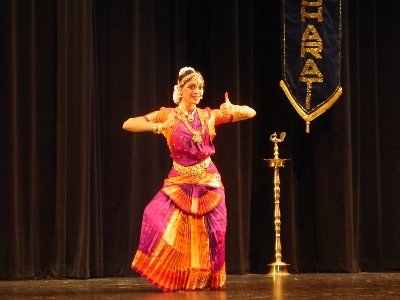
Apart from these, there are items such as Kautuvam, Koothu, Shlokam, Swarajathi,
Krithi etc. The performance concludes with the chanting of a few religious
verses as a form of benediction. Certain styles include more advanced items,
such as Tharanga Nritham and Suddha Nritham. When a dancer has mastered all the
elements of dance, as a coming out performance, he or she generally performs an
Arangetram (debut).
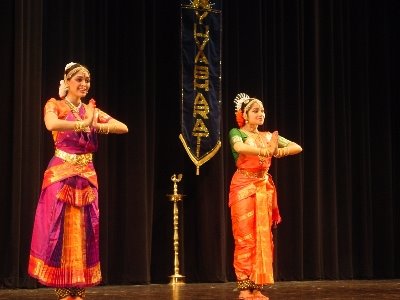
Other aspects
A male Bharatanatyam performerCostume - From the ancient texts and sculptures,
one can see that the original costume did not cover most of the dancers' bodies.
The medieval times, with the puritanistic drive, caused the devadasis to wear a
special, heavy saree that severely restricted the dance movements. There are
several varieties of Bharatanatyam costumes, some of which do not restrict the
dancer's movements, while the others do. The modern costumes are deeply
symbolic, as their purpose is to project the dancer's sukshma sharira (cf.aura),
in the material world.

Music - The accompanying music is in the Carnatic style of South India.
Ensemble - Mostly, South Indian instruments are used in the ensemble. These
include, the mridangam (drum), nagaswaram (long pipe horn made from a black
wood), the flute, violin and veena (stringed instrument traditionally associated
with Saraswati, the Hindu goddess of the arts and learning).
Languages - Tamil, Sanskrit, Telugu and Kannada are traditionally used in
Bharatanatyam.
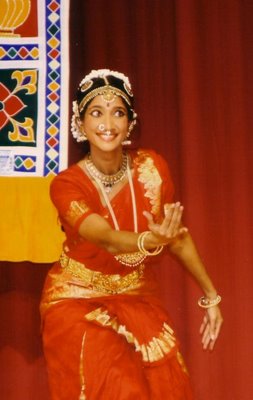
Ideal Qualities of Dancers
A professional Bharatanatyam dancer must demonstrate a number of qualities. As
Sangitaratnakara puts it, the true dance is connected to the beauty of the body,
therefore any other dance is simply a parody (VII.1246).

The AbhinayaDarpana has a sloka that describes Patra Prana Dasha Smrutaha - the
ten essentials of the dancer: Javaha (Agility), Sthirathvam (Steadiness), Rekha
(graceful lines), Bhramari(balance in pirouettes), Drishti (glance), Shramaha
(hard work), Medha (intelligence), Shraddha(devotion), Vacho (good speech), and
Geetam (singing ability).

A professional danseuse (patra), according to Abhinayadarpanam (one of the two
most authoritative texts on Bharatanatyam), must possess the following
qualities. She has to be youthful, slender, beautiful, with large eyes, with
well-rounded breasts, self-confident, witty, pleasing, well aware of when to
dance and when to stop, able to follow the flow of songs and music, and to dance
to the time (thalam), with splendid costumes, and of a happy disposition.

Bharata natyam: the origins
Bharata natyam, as Balasaraswati puts it, is an artistic yoga (natya yoga), for
revealing the spiritual through the corporeal. It is the most widely practised
of Indian classical dances in South India. It is the most ancient of all the
classical dance forms in India, which are based on Natya Shastra, the Bible of
the classical Indian dance. The term "Bharata natyam" was used by Purandara Dasa
(1484-1564). Later, Ghanam Krishnayyar's songs speak about a devadasi as an
expert at Bharata natyam. Subramania Bharathi also speaks about Bharata natyam.
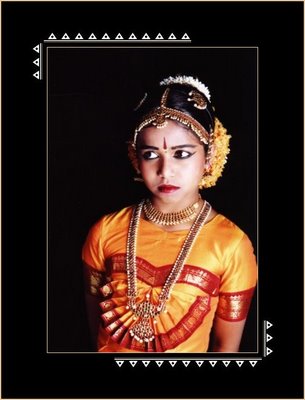
The legend and the inspiration
Gods and Godesses pleaded with Lord Brahma for another Veda to be created that
would be simple for the common man to understand, which is particularly
important in Kali Yuga. Granting their wish, Lord Brahma created the
Panchamaveda, the Fifth Veda, or NatyaVeda, a quintessence of the main four
Vedas. Brahma took pathya (words) form the Rigveda, abhinaya (communicative
elements of the body movements, cf. mime) from the Yajurveda, geeth (music and
chant) from Samaveda, and rasa (vital sentiment and emotional element) from
Atharvaveda to form the fifth Veda, NatyaVeda. After creating this Veda, Lord
Brahma handed it to sage Bharata and asked him to propagate it on earth. Obeying
the fiat of Lord Brahma, sage Bharata wrote down Natyashastra. Bharata together
with groups of the Gandharavas and Apsaras performed natya, nrtta and nrtya
before Siva. It became the most authoritative text on the artistic technique of
classical Indian dances, especially Bharata natyam and Odissi. It is also
possible that the term "Bharata natyam" partly owes its name to sage Bharata.

The Natya Shastra reads, "When the world had become steeped in greed and desire,
in jealousy and anger, in pleasure and pain, the Supreme One (Brahma) was asked
by the people to create an entertainment which could be seen and heard by all,
for the scriptures were not enjoyed by the masses, being too learned and
ambiguous." "This art is not merely for your pleasure, but exhibits cosmic
expression (bhava) for all the worlds. This art has been created following the
movements of the world in work and play, profit, peace, laughter, battle and
slaughter, yielding the fruit of righteousness to those who follow the moral
law, a restraint for the unruly, and a discipline for the followers of the rule;
to create wisdom in the ignorant, learning in scholars, afford sport to kings,
and endurance to the sorrow-stricken; it is replete with the diverse moods,
informed with varying passions of the soul, and linked to the deeds of mankind —
the best, the middling and the low — affording excellent counsel pastime and all
else."

Another version of the origin of Bharata natyam is that Goddess Parvathi taught
this dance art to Usha, daughter of demon Banasura. Usha handed it down to the
Gopikas of the city of Dwaraka, Lord Krishna's birth place. Lord Shiva is
himself the Supreme Dancer, and the whole Universe is His Divine Dance. Goddess
Parvathi dances with Him.One can imagine that the Gods and the Goddesses, being
dancers themselves, have been passing the art of the heavenly dance through many
other human channels, whose aptitude, understanding, and personal idiosyncrasies
naturally varied from person to person, and created a number of styles ranging
from Odissi to Bharata natyam.
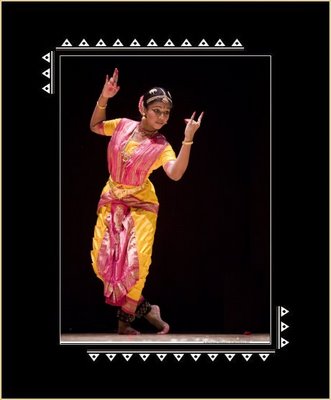
Bharata natyam has been undergoing a lot of change over the centuries. It used
to be and is still mostly performed by women dancers. Centuries ago the Hindu
temples in South India had dancers-priestesses called devadasis who would sing,
dance Dasi Attam (old version of Bharata natyam), play many musical instruments.
They were well-versed in Sanskrit and other languages as they had to adapt
compositions to suit the audience. The devadasi tradition gradually degraded.
Initially, devadasis lead a very strict and celibate life and were not allowed
to have a family. As the dance entered the royal courts, the dancers were called
Rajanartakis, who performed in the royal courts and gradually became royal
concubines. The British colonial rule has completely corrupted the devadasi
tradition.

In the first half of the 19th century much of Bharata natyam was redefined by
the contributions of four talented brothers known today as the Tanjore Quartet:
Chinniah, Sivanandam, Ponniah and Vadivelu. Styles of Bharata natyam were
preserved in practice mostly by the guru's and performers of the Isai Velalar
community of Tamil Nadu. The Tanjore Quartet organized all the basic Bharata
natyam movements of pure dance into a progressive series, adavus.
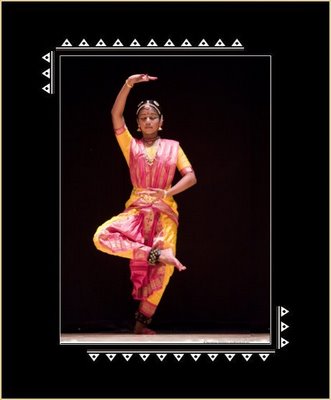
Each adavu is a basic unit taught in systematic order and then combined with
others to produce choreographed Bharata natyam sequences based upon the rhythmic
pattern of a musical composition. The brothers composed new music specifically
for Bharata natyam, and introduced a different sequence of items which
integrated various aspects of dance and music into a carefully coordinated,
aesthetically sound progression.
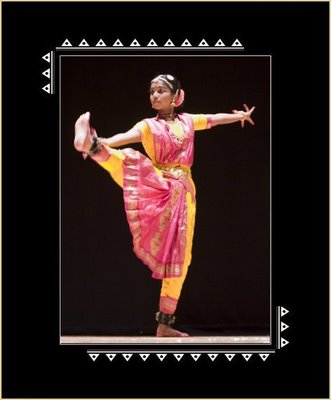
This infusion of creative energy marks the early 19th century as one of the most
innovative periods in the history of Bharata natyam. In the 20th century, such
prominent personalities as Mangudi Dorairaja Iyer and Krishna Iyer made their
significant contributions. The social status and image of Bharata natyam was
restored by Rukminidevi Arundale, the founder of Kalakshetra, who started
teaching a simplified, Kalakshetra style invented by her after having learnt
some of the Pandanallur style of Bharata natyam in a record 3 years' time.

Bharata natyam has undergone much change but is still deeply rooted in the
spiritual Hindu heritage. Contemporary classical Indian dancers are both male
and female artists. While most learn it as a hobby, very few make it their
career and a lifestyle, as it is extremely demanding and complex in terms of
dedication and daily practice. While most university degree courses offer the
theoretical base in Bharata natyam, there are institutions that offer
certificate and diploma courses with the focus on the practical skills.
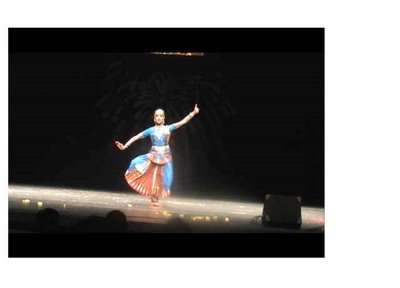
Most of the contemporary Bharata natyam choreographers and dancers may use some
of the formal Bharata natyam technique or its elements to stage ballets
presenting various themes such as nationalism, unity of religions, the sanctity
of the environment, the animal rights activism, the greatness of a king or a
political party, or even the delightfulness of Coca-Cola. In Vande Mataram, a
dance festival organised under the auspices of Natyarangam, a project of Narada
Gana Sabha in 1997 in Chennai, there was a host of topics: evils of the current
education system, the caste and reservation systems, threat of nuclear weapons,
AIDS, the population explosion, corruption in politics, bribery, religious
fanaticism, secularism, the greed for riches, the Chinese aggression, the Dandi
March, literacy, agriculture, mechanisation, industrialisation. Most recently,
some dancers of Nrityanjali Academy (Andhra Pradesh) managed to draw their
divine inspiration even from Condom Songs.

The true Bharata natyam, it has to be stated clearly, is not a vulgar form of
entertainment but a sacred ritual that is supposed to bring the rasanubhava
(catharsis, or spiritual upliftment) to the rasika (audience) and the dancer.

Bharata natyam technique
Balasaraswati has said: "Bharata natyam, in its highest moment, is the
embodiment of music in its visual form.... For more than thousand years, the
sastra's have confirmed that an individual dedicated to dance must be equally
dedicated to music and must receive thorough training in both the arts.. In
demonstrating the art of Bharata natyam abroad, I have made a special point of
showing audiences how delicately linked is the realisation of movement to raga
expression in abhinaya, including the subtle expression of gamaka's, intonation
of sruti, and the unfolding of improvisation in niraval. In the same way that we
look for perfect blending of raga and tala and of raga and bhava in abhinaya, so
also it is essential that the raga and the sahitya be perfectly matched and in
accordance with the necessities of expression in the dance."

"Sringara stands supreme in this range of emotions. No other emotion is capable
of better reflecting the mystic union of the human with the divine. I say this
with great personal experience of dancing to many great devotional songs, which
have had no element of sringara in them. Devotional songs are, of course,
necessary. However, sringara is the cardinal emotion, which gives the fullest
scope for artistic improvisation, branching off continually, as it does, into
the portrayal of innumerable moods full of newness and nuance.

If we approach Bharata natyam with humility, learn it with dedication and
practice it with devotion to God, sringara which brings out the great beauties
of this dance can be portrayed with all the purity of the spirit. The flesh,
which is considered to be an enemy of the spirit and the greatest obstacle to
spiritual realization, has itself been made a vehicle of the divine in the
discipline of the dance. Sringara thus is an instrument for uniting the dancer
with Divinity. Since the dancer has universalized her experience, all that she
goes through is also felt and experienced by the spectator".
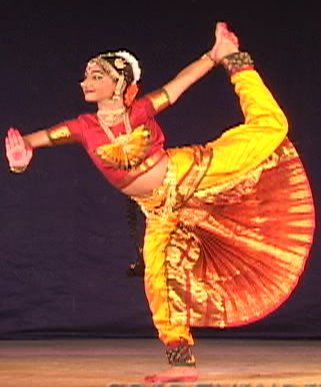
Bharata natyam comprises three aspects, Nritta, Nritya and Natya.
Nritta are rhythmical and repetitive elements, i.e. it is dance proper
Natya is the dramatic art, and is a language of gestures, poses and mime. cf.
Abhinaya
Nritya is a combination of Nritta and Natya.
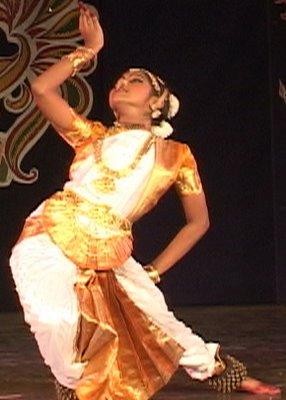
Nritta can be broadly divided into Chari, Karana, Angahara and Mandala.
One-leg movement are called Chari.
Two-leg movements are Karana.
3 Karanas make a Khanda.
3 to 4 Khandas make a Mandala.
4 to 9 Karanas make a Angahara.
4 to 5 Angaharas also make a Mandala.
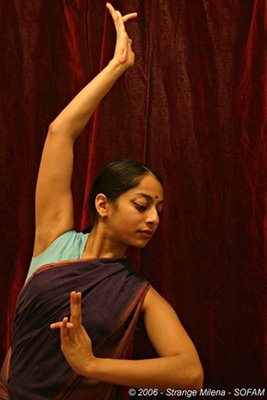
108 Karanas and 32 Angaharas are defined in Natyashatra. The 13 Nritta Hastas
(see below) are used to perform nritta. The rythmic body movements along with
hand gestures are called aduvus. A number of aduvus constitute a jati. Jati will
generally end with a Muktaya or Teermana.
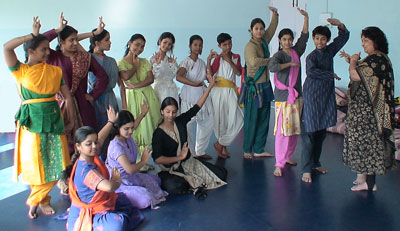
There are diferent types of Aduvus: Tattaduvu, Mettaduvu, Nataduvu, Kattaduvu,
Kudittamettaduvu, Maiaduvu, Mandiaduvu, Jati, Nadai, Ardi. There are 12 aduvus
in each type, making it 120 aduvus in total. Only about 70-80 are generally
practised by an average Bharata natyam dancer. Aduvus are often confused with
the 108 Karanas carved in the Chidambaram Temple in Tamilnadu, India.
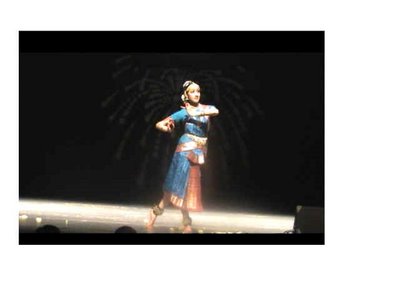
The entire body is divided into Anga, Pratyanga and Upaanga.
Anga :
Head, Hands, Chest, Waist, Bottom, Legs are the Six Angas.
Some Bharata natyam experts distinguish also Neck.
Pratyanga :
Shoulders, Arms, Stomuch, Thighs, Knees are the Six Pratyangas.
Some Bharata natyam experts distinguish also Wrists, Elbows and Ankles .
Upaanga :
Sight, Eyebrow, Eyelids, Eyeballs, Cheeks, Nose, Gums, Lower lip, Teeth, Tongue,
Chin and Face are the 12 Upaangas.
Some Bharata natyam experts distinguish also Heels, Fingers, Feet and Palms.
Pratynaga and Upaangas should move along with the Angas. Anga Lakshana, the
movements of body parts, are described below.
Shirobhedha - Head Movement
Greevabhedha - Neck Movement
Drushtibhedha - Eye Movement
Paadabhedha
Mandala - Standing Posture
Utplavana - Leaps
Bhramari - Circling Movement
Chari - Leg Movement
Gatibhedha - Charecteristic walks

Hastas or Mudras - Hand Movements:
Asamyuta Hasta
Samyuta Hasta
Deva Hasta
Dashavatara Hasta
Navagraha Hasta
Jaati Hasta
Bandhu Hasta
Nritta Hasta

When all Angas(main body parts) are coordinated (along with pratyanga and
upaanga), the Bharata natyam dancer is said to possess Angashudhi. Anga meaning
body parts, and shudhi means perfection or purity. The Natyashastra has shlokas
describing how to perform all the above movements.

The Dance performed by Lord Shiva is known as Tandava, virile aspect. The
tandava performed with bliss is called Ananda Tandava. The tandava of the
violent and destructive aspect is called Rudra Tandava. There are 7 types of
Tandava in Bharata natyam:
Ananda Tandava,
Tripura Tandava,
Sandhya Tandava,
Samara Tandava,
Kaali tandava,
Uma Tandava and
Gauri Tandava.

There are some Bharata natyam experts who distinguish 16 types of Tandava.
Tandava produces vigourous, brisk movements.
When the dance is performed by Goddess Parvathi, it is known as Lasya, where the
movements are soft, gentle, graceful and sometimes seen as er otic. Some Bharata
natyam scholars consider Lasya as the feminine version of Tandava. Lasya is of 2
kinds:
Jarita Lasya and
Yauvaka Lasya.

Abhinaya in Bharata natyam
The techniques of communicating a message are Abinaya. Here the emphasis is more
on facial expressions and gestures. While some authentic styles, such a Melattur
style of Bharata natyam, emphasise a highly expressive, spontaneous and elevated
mode of abhinaya, the late Balasaraswaty tradition's abhinaya was extremely
subtle and understated, while the Kalakshetra style expressions are largely
theatrical. Some contemporary styles, such as the one propagated by Shobana,
favour the Bollywood-type expressions.

While gestures can be seen from any distance even in a large dance hall, the
subtle facial expressions can only be seen from the front rows. This is the main
feature that distinguishes Bharata natyam from the western ballet. Thus, unless
a Bharata natyam recital is held in a small hall, a close-up, high-resolution
video is the only adequate medium of presenting the Abhinaya. Bharata natyam is
essentially ekaharya performance: a single dancer presenting various characters,
regardless of their gender.
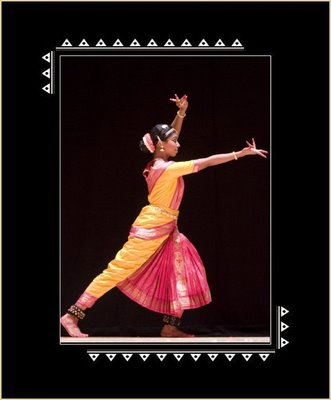
The Abinaya is comprised of
Angikabhinaya
Vachikabhinaya
Aharyabhinaya
Satvikabhinaya
Angikabhinaya : communicating the meaning of the songs using the body, i.e.
head, hands, legs, etc. The Bhedas come under Angikabhinaya.
Vachikabhinaya : communicating the story using narrations.
Aharyabhinaya : use of costumes, jewellary, make-up etc.
Satvikabhinaya : expressions of Bhava(moods)
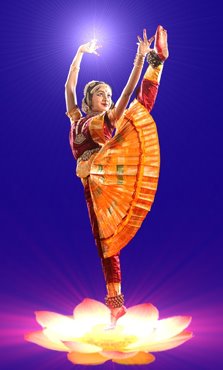
Lord Shiva is praised as the embodiment of the above 4 types of abinaya in this
following shloka.
Angikam bhuvanam yasya
Vachicam sarva vangmayam
Aharyam chandra taradi
tam vande satvikam shivam.
The meaning of the above shloka:
We bow to Him the benevolent One
Whose limbs are the world,
Whose song and poetry are the essence of all language,
Whose costume is the moon and the stars...
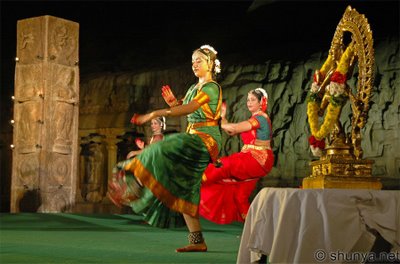
In Lord Shiva's well-known pose of NATARAJA:
his right hand holds the drum of creation, symbolising a new awakening
his left hand holds fire, representing destruction of the old order
his other right hand is raised in blessing
the other left hand points to his left foot, which has crushed demon Muyalaka
who represents ignorance.
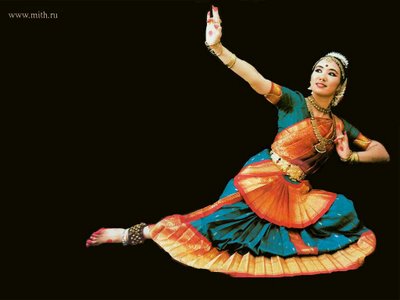
There are nine main or primary emotions, Sthayibhavas, also termed as Rasas
(Moods):
Shringara - Love
Hasya - Mirth
Veera - Heroism
Roudra - Anger
Bhayanaka - Terror
Bheebatsa - Disgust
Adbhuta - Wonder
Karuna - Compassion
Shanta - Tranquility
Vatsalya (parental fondling) rasa is also sometimes included as one of the
stayibhava.
Vibhava (cause of emotion), Anubhava (effect of emotion) and Sanchari bhava
(subordinate emotions) constitute the state of rasa.
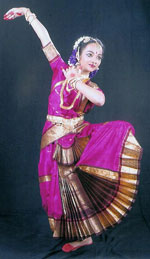
Nayika (the Heroine) and Nayaka (the Hero) bhavas:
The Nayika Bhava
The shastras have classified the basic mental status of woman, the Nayika, into
8 types, Ashtanayika bhavas. These divisions portray the heroine in different
situations, express different feelings, sentiments and reactions.
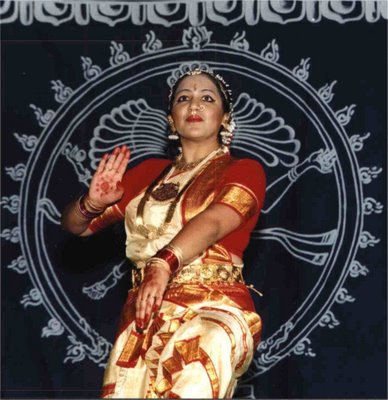
The Ashtanayika bhava are
Abhisarika
Kalahantarika
Khandita
Proshitapathika
Swadheenapathika
Vasakasajjika
Virahotkantita
Vipralabda
Abhisarika - She is the one who boldly goes out to meet her lover.
Kalahantarika - She is the one who is repenting her hastiness in quarrelling
with her lover, which has resulted in their separation.
Khandita - She is the one who is angry with her lover for causing her
dissapointment.
Proshitapathika - She is the one who is suffering and missing her beloved who is
away on a long journey.
Swadheenapathika - She is the one who is proud of her husband's or beloved's
love and loyalty.
Vasakasajjika - She is the one who is preparing for the arrival of her beloved,
by decorating herself and her surroundings to provide a pleasent welcome for her
lover.
Virahotkantita - She is the one who is seperated from her lover and is yearning
for reunion.
Vipralabda - She is the one who is dissapointed that her lover has not turned up
at the tryst as he promised.

Other classifications of the Nayika bhava in Bharata natyam are:
Mugdha - Inexperienced in love.
Madhya - Partly experienced in love.
Pragalbha - Mature in the art of love.
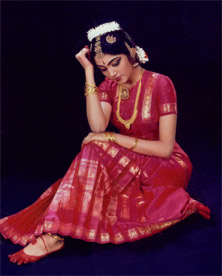
This Pragalbha Nayika is further classified as
Dheera
Adheera
Dheeraadheera
Sweeya - Married and faithful to her husband.
Parakeeya - Married but in love with another man.
Samanya - A free woman, who truly belongs to any man for a price.
Jyeshta - The preferred one.
Kanishta - The other woman.
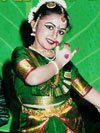
Further classifications are
Uttama - Self-controlled and tolerant.
Madhyama - Literally the middle one, who gives as she gets.
Adhama - Literally the low one, who has no self restraint.

The Companion to the Nayika plays an important role in any padam, javali or
Ashtapadi. This Companion is the one to whom the Nayika will convey her
feelings, she is the one who will take the message,if any, from the nayika to
the nayaka, she is the one who will sort out the differences between the nayika
and the nayaka. This companion is usuallly a girl who is close to the Nayika.
The classification of the Companion types in Bharata natyam:
Daasi - Servant
Sakhi - Friend
Kaaroo - Woman from a lower caste
Chatriya - Step Sister
Prativamshini - Neighbour
Lindini - Saint
Shilpani - Artist
Swaa - Nayika herself as a messenger
The Nayaka Bhava
Just like the heroines, the moods and emotions of the hero are also classified
into different types. The main types:
Dheerodaatta eg. Lord Rama
Dheeroddhata eg. Demon Ravana
Dheeralalita eg. Vatsaraaja
Dheerashanta eg. Buddha

Another classification is:
Pati - Married and faithful to his wife.
Upapati - Married but in love with another woman.
Vaisika - One who pays and enjoys women.
Further Nayaka classification:
Anukoola - Faithful to the Woman. eg. Lord Rama
Dakshina - Loves all his wives or women. eg. Arjuna
Drishta - When rejected, pleads to be accepted by his woman. eg. Vaali
Shatha - The deceitful one. eg. Lord Krishna
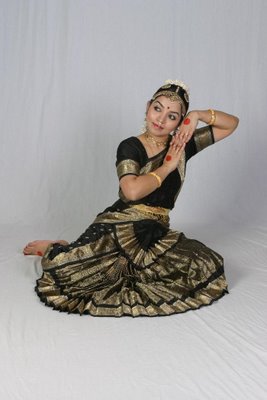
Most of the ashtanayika bhavas are experienced by the Nayaka also though the
depiction of ashtanayika is more than the nayaka. Nayaka's Companion plays an
important role too. This companion is categorised into
Peetamardhana
Vita
Cheta
Vidooshaka
These Bharata natyam elements are also seen as the mystic symbols of Bhakti
Yoga. Sringara means love, but this is not confined to rati sringara. There is
bhakti sringara and vatsalya sringara besides rati sringara. Even among some of
its practitioners, Bharata natyam is often misinterpreted as being limited
solely to bhakti. Balasaraswati believed Bharata natyam is based on bhakti and
that "it is justified in being called a yoga because it is a spiritual
discipline perfecting the mind to thought-free serenity".
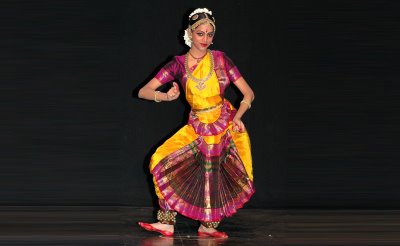
Styles of Bharata natyam
There are several original Bharata natyam styles that are over 150 years old:
Melattur
Pandanallur
Vazhuvoor (or Vizhuvur)
Thanjavoor (or Tanjore)
Mysore
Kanchipooram
The distinctive characteristics of the Melattur style of Bharata natyam are:
natural (spontaneous) and highly expressive abhinaya
largest amplitude of movements, which requires a higher degree of flexibility
emphasis on sringara bhakti
emphasis on crisp adavus, accuracy of jathis/ gathis,
fluid variations of patterned korvais
dramatic elements (characterisation)
original methods of application of principles of "loka dharmi" and "natya
dharmi"
The Pandanallur style of Bharata natyam stresses:
its deep sitting positions
its lasya (feminine dance style) of padams is rather slow and difficult to
perform
it is performed on three levels: in deep sitting positions, on the ground, in
standing positions and while moving or jumping.
The Vazhuvoor style of Bharata natyam includes:
wide range of dancing pace
static postures are inserted, most often in the tillana, to break the monotony
and to add the variety of rhythms
softer facial abhinaya
abhinaya is subtle with more natyadharmi (spontaneous expressions), so the
presentation is not "overdone"
the adavu's flow smoothly, with rare abrupt movements
extremely elaborate movements
deep sitting positions
variety of positions on the floor
rich sringar elements
lasya dominates tandava
the dancer's body from the waist up is stlightly bent forward
leaps are introduced into every jati
the jati's have more korvais (intervals), which creates a suspense effect
performance begins with a Thodaya mangalam in praise of Lord Gnana Sabesar of
Vazhuvoor
the dancer starts the performance while entering the stage from the wings
The modern Kalakshetra style is a simplified form based on Pandanallur and, to
some extent, Thanjavoor styles of Bharata natyam.
The Balasaraswati style, although derived from the authentic devadasi
traditions, is still a relatively recent introduction.
Note that, most recently, Dr.Padma Subramaniam's school, claiming to be the one
which is the most faithfully reflects the techniques described in Natya Shastra,
is called Bharatnrityam.

Bharata natyam dancers
In the ancient scriptures, a professional danseuse was called "patra". The
AbhinayaDarpana has a sloka that describes Patra Prana Dasha Smrutaha - the ten
essential qualitiess of the professional dancer:
Javaha (agility),
Sthirathvam (steadiness),
Rekhacha (graceful lines),
Bhramari(balance in pirouettes),
Drishtir (glance),
Shramaha (hard work),
Medha (intelligence),
Shraddha(devotion),
Vacho (good speech), and
Geetam (singing ability).

According to Abhinayadarpanam, one of the two most authoritative texts on
Bharata natyam, a patra must be
young,
slender,
beautiful,
large-eyed,
with well-rounded breasts,
self-confident,
witty,
pleasing,
capable of keeping time (following the rhythm)
splendidly dressed
of a happy disposition.
See more details in Natya shastra (XXVII.97-98).

The ten disqualifying criteria according to Abhinayadarpanam:
white specks in the apple of the eye
scanty hair
thick lips
pendant breasts
being either very fat or
very thin,
being either very tall or
very short
being hunch-backed
being either voiceless.

Classical Bharata natyam recitals and arangetram
A traditional format, margam (path), of a Bharata natyam performance, especially
important in the graduation performance, or Arangetram, is rather rigidly
structured, and reflects the different stages of the dancer's consciousness.

Aranga means raised stage and Etram meansclimbing in Tamil, one of the south
indian languages. It is also called Rangapravesha in Kannada, another south
indian language, Ranga meaning Stage and Pravesha meaning Enter. Ideally this
should be the first public appearance of the Bharata natyam artist. This is the
occation for the guru to present his/her deciple to the public. This is the
testing time for both the guru and the shishya(deciple) as the guru's knowledge
and the deciple's talent both are judged by the public. Hence, the guru will
decide when the deciple is ready for public graduation. Usually, at least 10-12
years of training is necessary before the Bharata natyam dancer is ready for
Arangetram.

Bharata natyam arangetram was known as Gejjepooje in the old Mysore district,
meaning worshiping the jingles in Kannada. For a Bharata natyam dancer, jingles
are considered divine. Formerly, deciples were not allowed to wear jingles till
their first public performance when they consecrated the jingles, wore them and
then performed.
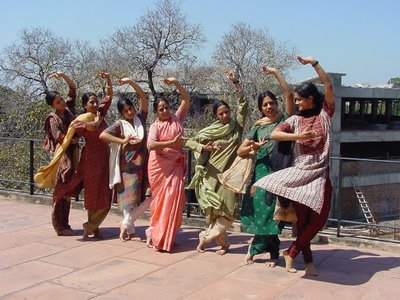
Accompaniments play a major role in the making of a memorable dance
performance.Basic accompaniments comprise a singer, a mridangam player, a violin
player and the Natuvanga. Veena, flute and other instruments are optional. These
people sit in the corner of a stage or in a place in front of the stage which
will be in a lower level than that of the stage. The Bharata natyam artist wears
lot of jewellery, make-up and a specially stitched dress. Jingles are a must.
Usually duration of a Bharata natyam arangetram will be 2 1/2 - 3 hours. To
perform for such long hours one must have good stamina and concentration. This
time is divided into two parts.

In the first half the Bharata natyam artists generally performs
Pushpanjali or Alaripu
Jatiswara
Shabda
Varna
In the second half:
Padam
Ashtapadi or Devaranama
Tillana
Mangala

Pushpanjali
This is an item where the Bharata natyam dancer salutes to god, guru and the
audience. This item is a warm-up item where the artist prepares the body for the
next hours of vigorous performance.

Alaripu ("budding flower")
Includes pure nritta. The movements are performed for syllables set for a beat
(Tala). The complexity of the movements gradually increase, as the dancer's
attention focusses more and more.. The steps are so formed that it looks like a
bud blooming into a flower. This is also a warm-up piece to prepare the body for
the next hours of Bharata natyam performance. Even though there is no obvious
message communicated here, this can also be considered as an item where the
artist salutes god, guru and the audience.
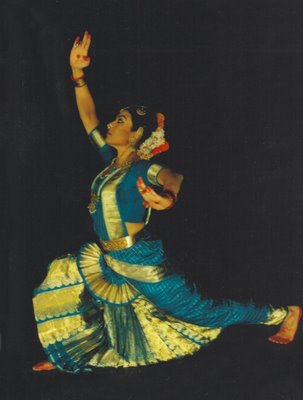
Jatiswaram
This is also an item where the movements will not convey any meaning or theme.
Here the steps are more complex than the previous items. The Bharata
natyamcomposition can have amazing postures and teermanas or muktayas (ending of
a jati). This is a musical composition set to a raga unlike alaripu which has
only syllables.

Shabda
This is a dance item with both nritta and abinaya. Usually the theme of the
lyrics will be devotional like praising lord Krishna, depicting Krishna's
childhood, praising a king etc.The movements here are leisurely. In the Sabdam,
emotions are withheld at the beginning; thereafter, when the dancer has
clarified herself, they are released in a measured and disciplined manner. It is
after, mastering this discipline that she dances the Varnam which is a living
river that holds together movement and interpretation.
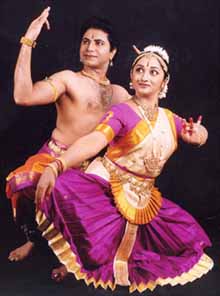
Varnam
This is the item where the Bharata natyam dancers are tested for their capacity
to perform both abinaya and nritta. This can be treated as a benchmark to judge
the artist's talent.The item will contain many complex steps and will have lot
of room for expressions also. To perform this item one should have lot of
stamina and concentration. The lyrics can be devotional, praising a king etc.
Varnam in Bharata natyam can also have shrigara rasa as its theme.

Padam
In this dance item the dancer's abhinaya is put into test. It narrates
expression of divine love or pangs of seperation in love. The tempo is slow and
the performance is based on a specific mood of love.Padams will have Nayaka
(Hero, Supreme lover, Divine Lord)and Nayika (Heroine, the yearning soul).
Heroine will talk to her friend (sakhi) and narrate her feelings towards her
hero. The Bharata natyam lyrics can be about how the hero has betrayed, how he
has delayed his arrival, how she is angry with her beloved hero etc. The Nayika
and Nayaka Bhavas are explained in detail here.
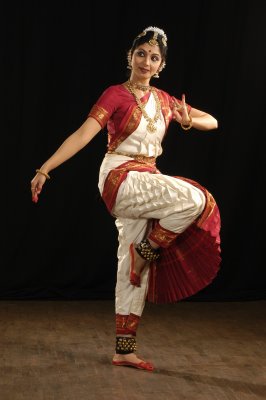
Ashtapadi
These are poet Jayadeva's Sanskrit compositions called Geetagovinda, an
extremely romantic composition. It describes the love of Krishna and Radha in
twelve cantos containing 24 songs. The songs are sung by Krishna or Radha or by
Radha's maid. Each Canto is named differently considering Krishna's status of
mind.

Saamodadamodara - Joyful Krishna
Aakleshakeshava - Careless Krishna
Mugdhamadhusoodhana - Bewildered Krishna
Snigdhamadhusoodhana - Tender Krishna
Saakankshapundareekaksha - Longing Krishna
Kuntavaikunta - Indolent Krishna
Naagaranaaraayana - Cunning Krishna
Vilakshalakshmeepatihi - Abashed Krishna
Mandamukunda - Languishing Krishna
Chaturachaturbhuja - Intelligent Krishna
Saanandadamodara - Blissful Krishna
Supreetapeetambara - Ecstatic Krishna

Expressions are given foremost importance while performing these poems. Needs
lot of grace. The Bharata natyam artist should be mature enough to understand
the lyrics and the situation to show the rasas.

Devaranama
This item is a devotional piece where the lyrics are in praise of god,
describing the god etc. This is a pure abhinaya item with almost no emphasis on
nritta. These songs are the Bharata natyam compositions of great mystics like
Purandharadaasa, Kanakadaasa, Vijayadaasa, Vyasaraaja to name a few. The Bharata
natyam compositions are popularly known as Daasa Sahitya. It is a devotional
literatures written in simple language understood by common man. It has made
remarkable contribution to the spiritual and cultural upliftment of people by
preaching phylosophy of Love, Devotion and Peaceful Co-Existance. If you are
looking for some Bharata natyam compositions, here they are.

Tillana
This is usually the last item in any Bharata natyam performance. Tillana is full
of complicated movements and postures. This will also have complicated Muktayas
or Sholkattu, ending of any step or aduvu. This is mainly a nritta piece which
might have a charana, a meaningfull lyrics for which abinaya is shown.

Mangala
Meaning ending the performance. Here the Bharata natyam artist will again salute
god, guru and the audience for making the performance a success.
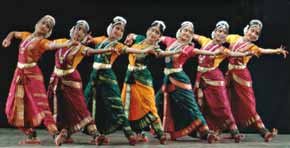
A Bharata natyam recital resembles the structure of a Hindu temple: first, one
passes through the gopuram (outer gate) of alarippu, then one crosses the
ardhamandapam (midway hall) of jatiswaram, next the mandapam (great hall of
worship) of sabdam and enter the heart of the temple in the varnam.
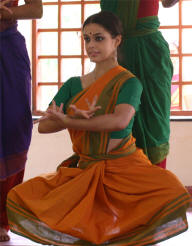
Bharata natyam is an attempt to embody the divine beauty, charm, rhythms and
symbols that exist in heaven.
Bharata natyam is a means of spiritual elevation both for the dancer and the
audience.
Bharatnatyam is one of the oldest documented classical dance forms in the world,
dating back to 1500 BC. It originated in Tamil Nadu of India, spread to the
neighbouring areas and developed into a national form. Temple dancers of South
India were its early exponents.
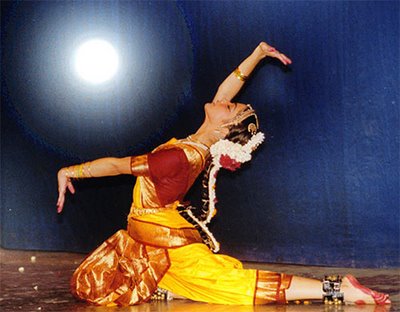
A highly developed classical dance, Bharatnatyam (Bharatanatyam) blends pure
lyric movement and pantomime drama. Modern performances sometimes last two hours
without interruption and are performed by a single or a group of dancers.
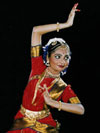
Rigid traditions govern every movement of the dance that much training is needed
to attain mastery of the dance form.
The beautiful art form from age old India, Bharatanatyam is known for its strong
foot work highlighted by the bells on the dancers ankles. Closely supported by
the purcussion instrument Mridangam as well as the dance conductors - cymbals
(nattuvangam), this dance flows along with the music explaining a story (natya)
or just pure dance (nritta) or a combination of both (nritya).
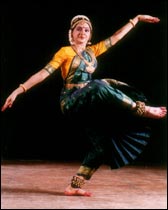
Indian Classical Dance is a wholesome art form - it is a great workout, very
graceful yet powerful, as spiritual/ religious as you want it to be, a high form
of yoga, revolves around beautiful musical compositions and rythms, Indian
mythology and theater and involves so many complementary art forms like costume
design and lighting, etc.

The Bharatanatyam Dance of India
Dance & Music are of great importance in the culture of India. Both arts are
very old, and they have close links not only with each other, but also with
Religion, Literature and Drama.
As in Europe after the 16th century, the temples of India were the centre of
community life and so became the focal point of the people's artistic
expression.
The ancient Bharata-natyam dance was originally a temple dance, and it has been
described as Poetry in Motion.
Its origins lie in the Natya Shastra, written around 1500 BC by the great sage,
Bharata Muni.
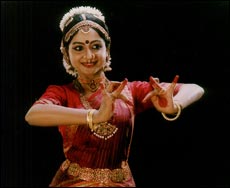
Since then, this dance form has been immortalized as much by great dancers, as
by sculptors who have demonstrated the perfection of its technique in the
flowing lines of temple sculptures.
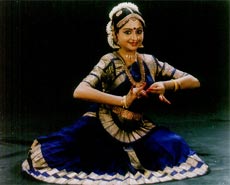
The structure of Bharata-natyam allows ample opportunity for the dancer to enjoy
the greatest sense of fulfillment in pure dance, where no other demands are made
on her except to harmonize with the melody and rhythm of the accompanying music.
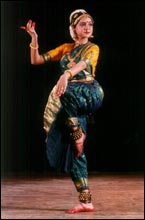
There are large sections of the dance in which the dancer must convey a story or
an emotional or spiritual state, and to master this is the ultimate test for the
dance. The interpretation of the lyrics in dance is interspersed by sections of
pure dance, without any specific relevance to the lyrics. These sections are
meant to provide dramatic relief within the composition, and to allow the dancer
to enjoy the freedom of pure dance. Since the dance has been handed down the
generations orally, the musicians and the dancer in these sections are usually
directed by the enunciation of mnemonic phrases that delineate the pattern that
the drummer and the dancer have to follow.
.jpg)
Originally known as Dasi Aattam, it is the classical dance that originated in
Tanjore, South India during the reign of King Sarabhooji (1798 - 1824 A. D). It
is one of the most highly developed and stylized dances.
Bharatha Natyam is a science in itself. It has been said that the Natya Shasthra
(science of Indian Dramatology, with 6000 stanzas) was enunciated by Lord
Brahma, written and compiled by sage Bharatha, and hence derived the name of
Bharatha Natyam. Another theory interprets the three syllables of Bharatha Natya
as 'Bha' (for Bhava or emotion), 'Ra' (for Raga or melody) and 'Ta' (for Tala or
rhythm). According to the critics, Natya Shasthra is said to have originated
sometime between 200 B.C and 200 A.D.
It has been said that the Natya Veda (scripture) was created by Lord Brahma by
combining aspects from the existing Vedas, such as the recitation or poetry from
the Rig Veda, the song from the Sama Veda, the gestures from the Yajur Veda, and
the sentiments and emotional aspects from the Atharva Veda.
This dance discipline has been handed down (by word of mouth and example) by the
gurus (teachers) to their chelas (disciples). Over the years Bharatha Natyam has
become more creative and innovative, and the original style has gone through
numerous changes, but it still has preserved its original regional flavor and
essence.
Originally, its chief exponents were the devadasis or women dedicated to the
service of the Gods, but social reformers associated the dance with pagan
worship, banned it as being disreputable, and the devadasis were prohibited from
performing this art form. It was not until the early part of the 20th century
that the dance was revived, and popularized among the various classes in
society, thus opening the way for future dancers. Rukmani Devi Arundale of the
famous "Kalakshethra" school of dancing was one of the pioneers in this
movement.
The basic unit of this dance is called the Adavu. They belong to the realm of
Nritta. Some of the common adavus are Tattu Adavu (to strike flat), Naatu Adavu
(the use of one's heels) and so on. Adavus are combined to form what is called a
korvai. Sizable sequences of these rhythmic phrases, set to a determined format
are known as Jathis. There are five types of Jathis based on three counts
(Thishra), four counts (Chathushra), five counts (Khanta), seven counts (Mishra)
and nine counts (Sangeerana). Teermaanam (meaning 'to conclude') refers to a
group of rhythmic phrases that are positioned in the dance is such a way that
they terminate exactly at the beginning of the cycle of rhythm on which the
dance is based on. In a way, Teermaanams provide lively flourishes to the
composition (rendered three times in succession).
The vocal representation used for Jathis are called Sollukatus and recited by
the Nattuvanar (conductor). A small block of wood (called the tattukali) along
with a wooden stick (which is used to tap the rhythmic patterns on this block)
are used for practice sessions.
Tala refers to the rhythm or beats. There are different time measures based on a
unit of time (or the kaala).
Raga is the tune, or the melody in which each item is composed.
The main languages used it the songs are Sanskrit, Tamil and Telugu
Bharatha Natyam shares the basic principles with the other classical dances, and
falls into three main categories:
Nritta or pure dance, which consists of movements (of the body and limbs) which
are performed for the visual beauty they create, and not signify any particular
mood, emotion or meaning. It encompasses steps and movements in the form of
patterns of dance. It has pure aesthetic value.
Nritya is that element that suggests sentiment and mood (bhava). It emphasizes
on expressions essentially through stylized gestures of the hands, fingers and
other parts of the body. It emphasizes on Abhinaya (a Sanskrit word which means,
"To carry to the spectators or audience"). Abhinaya itself is classified into
four categories:
1. Aangik Abhinaya, which relates to the gestures of the body, the head, eyes,
neck, and the movements of the hands called hasthas, which are formed with
either one or both hands. This Abhinaya also relates to the postures of the
body, hand and foot movements, called "karanas". There are 108 karanas.
2. Saathvik Abhinaya is about the mental and emotional states called rasas of
which there are nine.
Shringar or Love
Hasya or Humor
Karuna or Pathos
Rudra ( Raudra) or Anger
Vir or Bravery
Bhayaanaka or Terror
Bibhastha or Disgust
Adbudha or Wonder
Shantha or Serenity
3. Vaachik Abhinaya relates to the dancer's use of poetry and song.
4. Aahaarya Abhinaya relates to jewelry, costumes, and makeup.
Natya relates to the dramatic aspect of the dance, and is a combination of both
Nritta and Nritya. It is the dramatic element of a stage performance, mimicking
the life and stories of the gods and the asuras (demons).
Before starting and ending a performance, the dancer always salutes the deity
with a small gesture called 'Thatti Kumbudu' ('Kumbudu' in Tamil means 'to pray'
or to salute with both palms joined together to form a Namasthe.). It has also
been said that it is a salutation to Mother Earth. The components of a typical
Bharatha Natyam recital in a given order are:
The Allarippu and the Kauthuvam, which are invocations and prayers to the
presiding deity. They are used to open a performance. The term Allarippu is
derived from a word in Telugu called Alarimpu, which means, 'to decorate with
flowers'. It falls into the Nritta category.
The Jathiswaram, which is a form of pure dance, set to definite patterns of
syllables and a specific Raga or melody form. The swaras are sung in a raga.
The Shabdam, which is a judicious mixture of both pure and interpretative dance.
Shabdams are usually set to a string of Ragas (Ragamalika). A raga commonly
associated with the Shabdam is the raga Kamboji.
The Varnam, which is by far, the most complex composition, combining pure and
expressive dancing. It is normally based on a love theme.
Dances of exclusively expressive nature, like the shlokas, padams, jawalis and
kritis follow the Varnam and convey specific love themes and situations. They
emphasize on Bhava, Saathvik and Vaachika Abhinaya. Also included in this set of
dances are dances like the Andal Thiruppavai (a set of bhajans written by Andal,
a devotee of Lord Narayana), the gypsy dance (called 'kurathi' in Tamil) and so
on.
The Thillana is a fantasy of pure dancing combining intricate footwork and
beautiful poses, and is a display of the complete form of this art. It is said
that this originated in North India, and was later brought into South India
during the rules of the Mughuls.
The Mangalam (prayer) marks the end of a recital.